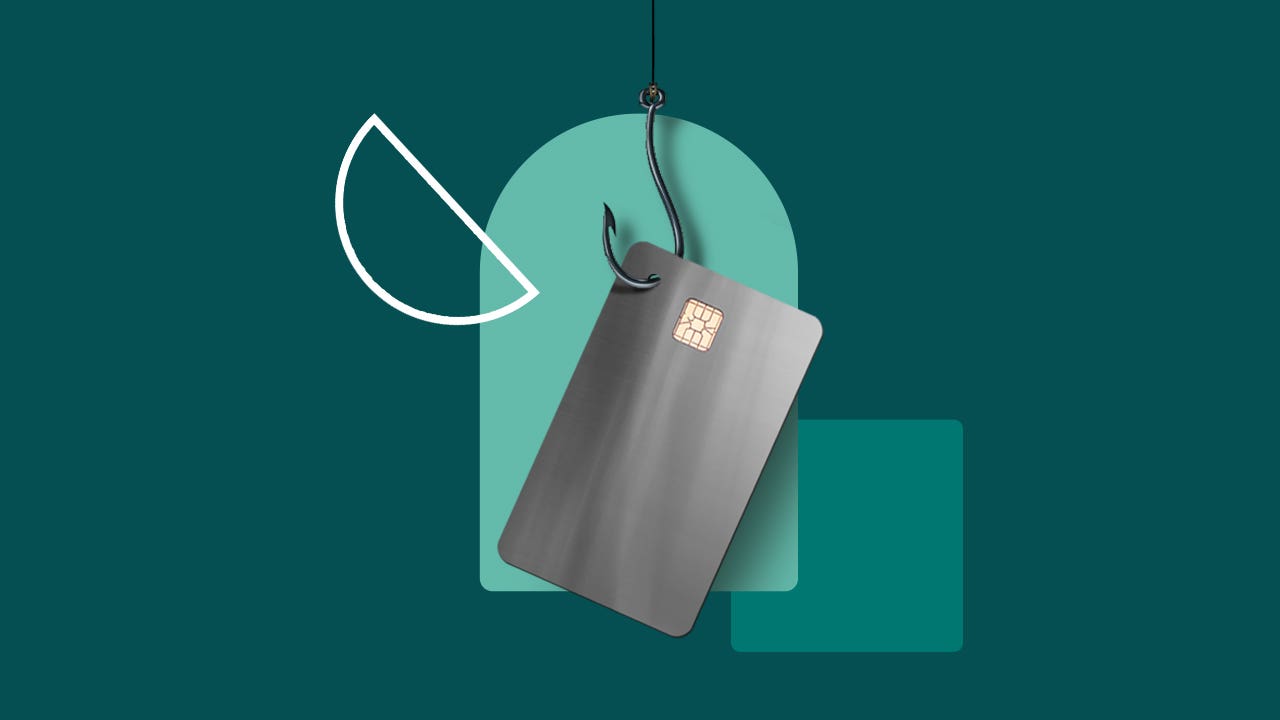Credit card fraud statistics

The Bankrate promise
At Bankrate we strive to help you make smarter financial decisions. While we adhere to strict , this post may contain references to products from our partners. Here's an explanation for . The content on this page is accurate as of the posting date; however, some of the offers mentioned may have expired. Terms apply to the offers listed on this page. Any opinions, analyses, reviews or recommendations expressed in this article are those of the author’s alone, and have not been reviewed, approved or otherwise endorsed by any card issuer.
In 2021, the Federal Trade Commission (FTC) fielded nearly 390,000 reports of credit card fraud, making it one of the most common kinds of fraud in the U.S. But that figure doesn’t begin to offer a complete view of the problem.
In December 2022, the Nilson Report, which monitors the payments industry, released a forecast indicating that U.S. losses from card fraud will total $165.1 billion over the next 10 years, plaguing every age group in every state. Just one type of credit card fraud — card-not-present fraud, which involves online, over-the-phone and mail-order transactions — accounted for an estimated $5.72 billion in U.S. losses in 2022, according to Insider Intelligence.
Credit card fraud happens when someone uses credit card information to make unauthorized transactions, such as buying merchandise on Amazon. Aside from card-not-present fraud, types of credit card fraud include identity theft and stolen credit cards. While the problem of credit card fraud looms large, you can take steps to prevent becoming another credit card fraud statistic.
- Total number of U.S. credit card fraud reports in 2021: 389,737 (FTC)
- Number of U.S. adults who have been victims of credit credit fraud: 127 million (Security.org)
- Percentage of U.S. fraud reports that involved financial losses in 2021: 26 percent (FTC)
- U.S. percentage of worldwide card fraud in 2021: 36.8 percent (Nilson Report)
- Dollar amount the U.S. card industry stands to lose to fraud over the next 10 years: $165.1 billion (Nilson Report)
- Number of credit card fraud attempts at U.S. retailers each month: 1,740 (Chargebacks911)
Types of credit card fraud
Credit card fraud occurs in a variety of ways. Here are six of the most common types.
- Card-not-present fraud. Card-not-present fraud happens when someone uses your credit card information, but not your actual card, to carry out an unauthorized transaction online, over the phone or by mail order.
- Identity theft. Identity theft takes place when someone uses your personal information, such as your Social Security number or credit card number, to commit fraud or other crimes. In 2021, the Federal Trade Commission received nearly 1.4 million reports of identity theft.
- Skimming. Skimming happens when criminals illegally place devices on ATMs, point-of-sale terminals or gas pumps to steal data, including card numbers and PINs. With this information, crooks can generate phony credit or debit cards. Financial losses from skimming are estimated to be more than $1 billion each year.
- Phishing. Phishing enables fraudsters to steal your information, such as passwords or account numbers, through emails or text messages. Criminals can then gain access to your credit card, bank and email accounts. They also might sell your information to other crooks.
- Account takeover. Account takeover occurs when a cybercriminal assumes ownership of someone else’s online account with a stolen username or password. Generally, crooks buy usernames and passwords on the so-called “dark web.”
- Lost or stolen credit cards. If you lose your credit card or it’s stolen, someone else may use it to make unauthorized transactions. You should report a lost or stolen card to the card issuer as soon as possible.
Credit card fraud in the United States
In 2021, credit card fraud ranked as the second most common type of identity theft in the U.S., behind fraud involving government benefits or documents, according to the FTC.
In many cases, card issuers, merchants, payment processors and ATM transaction processors eat financial losses attributed to credit card fraud. In 2020, card issuers assumed 65.4 percent of the losses [PDF], with merchants, ATM acquirers and merchant acquirers accounting for the remaining 34.6 percent, the Nilson Report says. Acquirers process ATM and merchant transactions.
Neither consumers nor businesses seem to be able to escape credit card fraud, as fraud-fighting measures have been challenged by “ever more sophisticated” ways that crooks commit fraud, according to the Nilson Report. In December 2022, the Nilson Report said it expects global losses from card fraud to total $397.4 billion over the next 10 years, with $165.1 billion of those losses happening in the U.S.
| Year | Amount (In billions) |
|---|---|
| Source: Card Fraud Worldwide | |
| 2021 | 32.34 |
| 2020 | 28.43 |
| 2019 | 28.65 |
| 2018 | 27.86 |
| 2017 | 23.97 |
| 2016 | 22.80 |
| 2015 | 21.84 |
| 2014 | 18.11 |
Year after year, reports of debit card fraud, credit card fraud and associated financial losses continue to climb, with the pandemic year of 2020 being an outlier. The Nilson Report, which tracks the payments industry, predicts global fraud losses related to payment cards will reach $47.22 billion in 2031, including $19.24 trillion in the U.S.
| Year | Credit card fraud reports |
|---|---|
| Source: Consumer Sentinel Network Data Book 2021 | |
| 2017 | 133,107 |
| 2018 | 157,745 |
| 2019 | 271,938 |
| 2020 | 393,378 |
| 2021 | 389,737 |
Fraud reports by payment method
Although credit cards represented the most U.S. fraud reports by payment method in 2021, they ranked sixth for total dollar loss, according to the FTC. Bank transfers and payments accounted for the highest monetary losses reported in 2021 ($756 million), followed by cryptocurrency ($750 million).
Losses attributed to credit cards totaled $181 million, above debit cards ($140 million) but below gift cards and reload cards ($233 million), the FTC says.
Credit card fraud by age
In 2021, Americans ages 30 to 39 reported the most incidents of credit card fraud: 108,592. That represents one-third of credit card fraud reports among all age groups.
| Age group | Credit card fraud reports |
|---|---|
| Source: Consumer Sentinel Network Data Book 2021 | |
| 19 and under | 1,707 |
| 20-29 | 65,269 |
| 30-39 | 108,592 |
| 40-49 | 76,693 |
| 50-59 | 45,741 |
| 60-69 | 21,992 |
| 70-79 | 7,507 |
| 80 and over | 1,954 |
Credit card fraud by state
As you’d expect, the number of credit card fraud reports and financial losses tends to be higher in states with a larger population and lower in states with a smaller population. But on a per capita basis, Rhode Island topped the FTC’s list for identity theft reports in 2021, followed by Kansas, Illinois, Louisiana and Georgia.
-
State Credit card fraud victim count Credit card fraud victim loss amount Source: 2021 IC3 Annual Report Alabama 622 $1,577,664 Alaska 58 $252,476 Arizona 390 $3,100,451 Arkansas 93 $294,796 California 2,455 $38,545,383 Colorado 292 $1,935,416 Connecticut 149 $2,853,740 Delaware 53 $1,521,628 Florida 1,539 $16,784,459 Georgia 359 $3,312,955 Hawaii 48 $540,009 Idaho 64 $618,403 Illinois 428 $2,953,531 Indiana 229 $1,164,687 Iowa 77 $846,597 Kansas 89 $622,723 Kentucky 200 $983,372 Louisiana 147 $2,182,039 Maine 45 $205,618 Maryland 306 $2,527,660 Massachusetts 273 $3,815,762 Michigan 335 $2,720,612 Minnesota 162 $1,494,686 Mississippi 80 $161,802 Missouri 225 $884,503 Montana 45 $326,093 Nebraska 58 $325,391 Nevada 519 $2,703,087 New Hampshire 38 $159,691 New Jersey 400 $6,553,622 New Mexico 79 $343,474 New York 1,028 $14,979,202 North Carolina 342 $1,511,481 North Dakota 12 $13,643 Ohio 716 $2,464,446 Oklahoma 146 $604,722 Oregon 205 $1,804,904 Pennsylvania 571 $9,261,284 Rhode Island 42 $181,981 South Carolina 189 $519,358 South Dakota 27 $33,919 Tennessee 271 $1,959,585 Texas 1,104 $12,357,119 Utah 188 $3,499,300 Vermont 21 $63,134 Virginia 398 $4,577,719 Washington 406 $6,723,596 West Virginia 60 $544,754 Wisconsin 177 $796,763 Wyoming 29 $184,048
How to protect yourself from credit card fraud
While it might seem impossible to protect yourself from credit card fraud, it can be done. Here are 12 tips for preventing fraudsters from causing financial harm.
- Make it a habit to regularly check your credit reports. Watch for any suspicious activity.
- Frequently review your bank statements and credit card statements. Comb through them to spot unauthorized transactions.
- Don’t use public Wi-Fi to complete financial transactions.
- Consider setting up a credit freeze, which restricts access to your credit reports.
- If you’ve been the victim of credit card fraud, place a fraud alert on your credit reports.
- Shred documents that include personal information, such as a credit card number or Social Security number.
- Don’t provide credit card information over the phone unless you initiated the call.
- Verify that a website is secure before transacting business or entering personal information by looking for URLs that start with https:// at the top of your web browser.
- Create hard-to-guess passwords for your online accounts.
- Use multi-factor authentication (MFA), which requires at least two ways (such as a PIN and a fingerprint) to verify your identity before you can log in to an online account.
- Install antivirus software and other technology to boost the security of your electronic devices.
- Consider a digital wallet, which enables you to use your smartphone for credit card transactions rather than a physical card.
FAQs
-
Credit card fraud is a type of identity theft. It happens when someone steals your credit card information to make unauthorized transactions. In many cases, credit card companies won’t hold you liable for unauthorized transactions due to fraud.
-
If you think you’ve been the victim of credit card fraud, contact the card issuer by phone or live chat as soon as possible. Tell the customer service representative that you believe you’ve been victimized by credit card fraud, and ask that the affected account be suspended or closed. In addition, file an identity theft report on the FTC’s IdentityTheft.gov website and notify the three main credit bureaus (Equifax, Experian and TransUnion).
-
Credit card fraud can affect your credit if the fraud goes undetected. For instance, missed or late payments on a new account opened under your name could cause negative information to appear on your credit reports. Or, if fraudulent charges make it appear as though you’re using more of your available credit, this could result in your credit utilization ratio going up, which will negatively impact your credit score.
Related Articles


Preventing identity theft: How common it is and how to protect yourself

